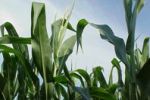In-Season Decisions
Originally written February 1, 2006 | Last updated
March 03, 2014
 The life-cycle and growing season of crop plants utilizes all available management
strategies, including cultural, pest management, physical, biological and chemical
options to prevent economically damaging pest outbreaks and to reduce risks to human
health and the environment. Plants are subjected to a combination of stresses. Stresses
are researched intensely individually; combinations are less so. Examples of abiotic stress include: cool wet soils, chilling, freezing, heat, water
(flood and drought), wind, hail, nutrients, ozone, ultra-violet radiation, and salinity.
Biotic factors include: neighbor competition for resources (inter-
and intra-plant competition), diseases, insects, weeds, nematodes, etc. In a field,
even more combinations of stresses can be occurring due to "patchiness" of abiotic
and biotic stresses interacting with soil and micr-climate.
The life-cycle and growing season of crop plants utilizes all available management
strategies, including cultural, pest management, physical, biological and chemical
options to prevent economically damaging pest outbreaks and to reduce risks to human
health and the environment. Plants are subjected to a combination of stresses. Stresses
are researched intensely individually; combinations are less so. Examples of abiotic stress include: cool wet soils, chilling, freezing, heat, water
(flood and drought), wind, hail, nutrients, ozone, ultra-violet radiation, and salinity.
Biotic factors include: neighbor competition for resources (inter-
and intra-plant competition), diseases, insects, weeds, nematodes, etc. In a field,
even more combinations of stresses can be occurring due to "patchiness" of abiotic
and biotic stresses interacting with soil and micr-climate.
In-season management decisions are a continuum of management practices that range
from simple field scouting to biointensive, integrated approaches which utilize
a systems approach to crop and pest management. Action thresholds have been incorporated
into many programs to assist with the decision making process. Economic thresholds
have been developed for crops where yield is the primary concern. For pests, the
economic threshold is that pest level at which control practices
must be implemented to prevent economic damage (i.e. cost of control
is less than expected damage). For abiotic factors, similar damage estimates
have been estimated to determine impacts on yield .
We cannot control everything. Our focus needs to be on management through hybrid/variety
selection, pest management options, tillage, irrigation, and fertilizer application.
Consideration must be given to how one management practice impacts other components
of the system.